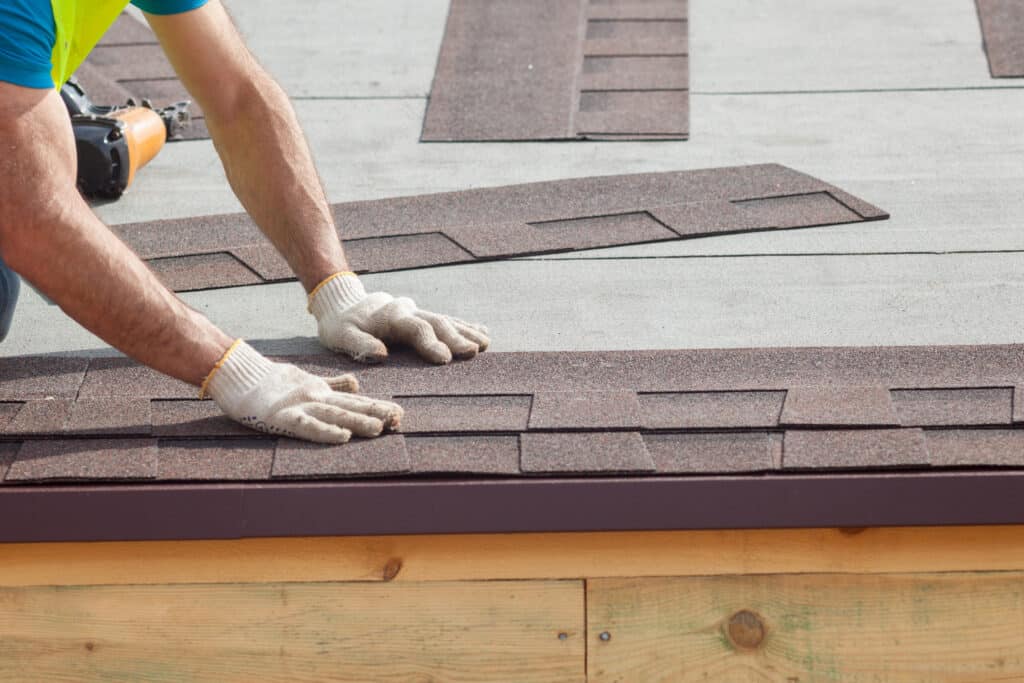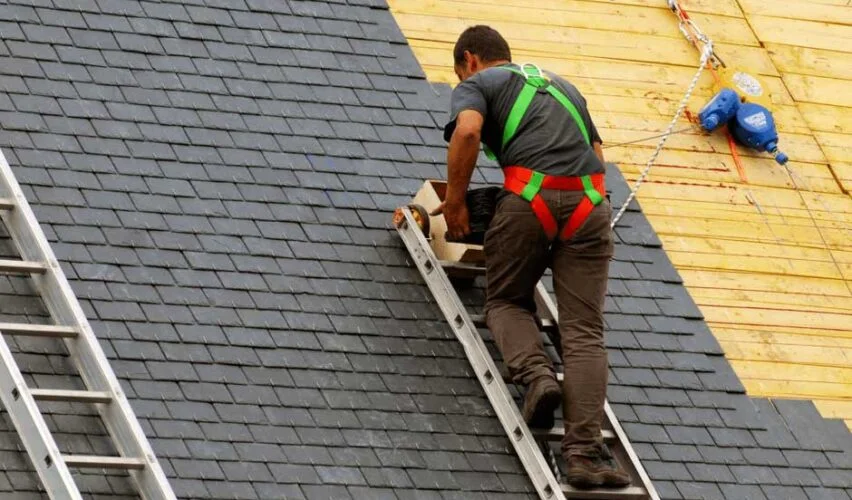A damaged roof can lead to more than just leaks; it can ruin insulation, raise energy bills, and even put your home’s structure at risk. But how do you know if your roof needs just a quick repair or a full replacement? That’s a question many homeowners face, especially if they don’t know what signs to look for.
In this blog, we’ll discuss how to spot roof damage, understand roof replacement vs roof repair, and explore ways to protect your roof in the long run.
How to Know If Your Roof Is in Trouble
Your roof quietly protects your home every day from the sun, rain, wind, and snow. But when it starts to fail, the signs aren’t always loud and obvious. Small problems can grow into costly damage if left unnoticed for too long.
In this section, we’ll break down some of the most common signs of roof trouble that every homeowner should know, especially if you’ve never thought about your roof before.
Damaged or Missing Shingles
One of the most obvious signs of roof damage is when shingles start to crack, curl, or disappear entirely. Shingles act as a protective layer for your roof, and regular roof maintenance can help catch these issues early. When they’re broken or missing, your home becomes vulnerable to water leaks and wind damage. With proper maintenance, you might avoid seeing bare patches on your roof or finding loose shingles on the ground after a storm.
These issues can seem small at first, but ignoring them can lead to bigger problems, like water damage or mold growth inside your home. Think of shingles like the armor of your roof—if it’s chipped or falling off, the rest of your roof is exposed and at risk.
Ceiling or Wall Stains
Have you noticed brownish or yellow spots on your ceiling or upper walls? That’s usually a warning sign that water is making its way into your home through the roof. These stains are more than just cosmetic; they often mean there’s a leak that needs attention.
When water gets in through damaged areas on the roof, it can travel down into your walls and ceilings, leaving visible marks behind. If you spot these stains, especially after it rains, don’t brush them off—they’re usually the tip of the iceberg.
Light in the Attic
If you head into your attic during the day and see streaks of sunlight shining through the roof boards, that’s a bad sign. While it may not seem serious, those gaps mean that your roof isn’t sealed properly anymore.
If light can pass through, so can rain, cold air, and even pests. These small holes can quickly become larger issues, leading to damp insulation, wood rot, or water dripping into your home. Sealing them up early can prevent a bigger repair bill later on.
Read More: How to Fix Roof Creaking Sounds and What They Might Mean
Sagging Roof
A roof should look straight and even. If you see parts of it starting to dip or sag, especially in the middle, it could be a sign of structural damage. This often happens when water has been leaking in over time and weakening the roof’s support.
Sagging is serious because it means the frame underneath is stressed or rotting. It can put your home at risk of major damage, especially during storms or under heavy snow. Don’t wait on this one—have a professional check it right away.
Mold or Musty Smells
A damp, musty smell in your attic or upper rooms often points to moisture sneaking in through the roof. Over time, that moisture can lead to mold growing on beams, insulation, or even drywall.
Not only can mold damage your home, it can also affect your health, especially for those with allergies or asthma. If something smells off or you spot fuzzy growth on attic surfaces, it’s a red flag that water is getting where it shouldn’t.
Granules in Gutters
When cleaning your gutters, you might notice small, sand-like granules. These come from asphalt shingles and are meant to protect them from the sun. Over time, shingles lose granules naturally, but too much loss too fast is a sign of wear.
If your gutters are filling up with granules, your roof might be aging faster than expected. Worn shingles don’t shield your home as well, and that means it’s more vulnerable to sun, wind, and rain damage.
Rising Energy Bills
If your energy costs are suddenly going up but your usage hasn’t changed, your roof might be the culprit. Poor insulation, air leaks, or hidden damage can make your heating and cooling systems work harder.
A well-sealed roof keeps indoor temperatures stable. But when your roof is damaged or aging, air can escape—and your HVAC system has to overcompensate. That leads to higher bills and a less comfortable home environment.
Read More: How to Repair a Leaking Metal Roof
How to Decide Between Repair or Replace?
After you’ve determined that your roof has suffered damage, you have two main choices: repair or replacement. Your decision will depend on the severity of the damage, the age of your roof, and your long-term goals. While roof leak repair can be a quick and cost-effective fix for minor issues, replacement might be necessary for more significant or widespread damage. Knowing when to repair and when to replace is crucial for ensuring your home remains safe and secure.
Now, we’ll dive into the differences between roof repairs and replacements based on factors like cost, time, longevity, and effectiveness, helping you choose the best option for your home.
Quick & Affordable Repairs
Repairs are often ideal when the damage is minor, such as a few missing shingles or a small leak. They’re typically faster and less expensive than a full replacement, especially for localized issues. If your roof is fairly new and only has small problems, repairs can extend its life without the need for a full overhaul.
However, if the damage is more widespread or the roof is older, repairs may only provide a temporary fix, leading to more costs down the road. Over time, constant repairs can become a bigger financial burden than simply replacing the roof.
Long-Term Replacement
Replacement is the better option when the damage is extensive or your roof is nearing the end of its life. Though it’s a larger investment upfront, a new roof can last for 20 to 30 years, providing more security and better protection from the elements. This long-term solution reduces the need for future repairs.
If your roof has already undergone several repairs or is old, opting for a full replacement might be more economical and stress-free in the long run. A new roof will prevent ongoing maintenance costs and potential risks of further damage to your home’s structure.
Cost Comparison
The immediate cost of repairs is usually much lower than replacement, with minor fixes often costing just a few hundred to a couple of thousand dollars. If you’re on a tight budget or need a quick solution, repairs are a more affordable option. They can often be completed in a day or two.
However, be mindful that frequent repairs can add up over time. If you find yourself constantly patching up the roof due to recurring issues, replacing it entirely may be more economical in the long run. A new roof may require a higher initial investment but offers significant savings over time.
Time to Complete
Repairs can usually be completed in just a day or two, meaning minimal disruption to your daily routine. This makes repairs an ideal option when you need a quick fix. The roofing contractor will only need a short amount of time to address specific problems.
On the other hand, a full roof replacement takes several days and can be more disruptive to your home life. However, it ensures long-term durability, reducing the need for frequent repairs in the future. If you’re not in a rush and want a lasting solution, replacement might be worth the wait.
Longevity of the Solution
Repairs can extend the life of your roof, but they only offer short-term protection, especially if the damage is minor or the roof is old. As your roof ages, repairs become less effective and may only last a few years before more issues arise.
In contrast, a roof replacement offers long-term durability, lasting for 20 to 30 years. By opting for a new roof, you’ll avoid the hassle of frequent repairs and ensure peace of mind knowing your home is well-protected against the elements for decades.
Read More: What’s the Difference Between Shingle Metal and Tile Roofing?
Preventing Future Roof Damage
After repairing or replacing your roof, the next step is making sure it stays protected for the long haul. Preventive care is often overlooked, but it can save you thousands in the long run. A well-maintained roof not only lasts longer but also keeps your home safe and dry in every season.
Let’s look at a few simple ways to protect your roof and avoid future damage.
Inspect Regularly
Regular roof inspections help catch small problems before they escalate into expensive repairs. It’s recommended to check your roof twice a year, in spring and fall, to identify issues like missing shingles, sagging, or wear. Inspecting at these times ensures your roof is prepared for the upcoming seasons.
After storms, inspect your roof for damage, as high winds can loosen shingles and cause leaks. If you can’t access the roof, use binoculars for a ground-level inspection. If you spot any concerns, hire a professional for a more detailed evaluation to prevent further damage.
Clean Gutters
Clogged gutters can lead to roof damage by trapping water and causing it to back up under shingles. This can result in rot, mold, and structural damage. Clean your gutters regularly, especially after fall, to prevent debris build-up and ensure proper drainage.
Consider installing gutter guards to minimize debris collection and reduce maintenance. Keeping gutters clear helps water flow freely, protecting your roof from water damage and extending its lifespan.
Trim Trees
Overhanging tree branches can scrape shingles, or fallen limbs during storms can cause significant roof damage. Regularly trim trees near your roof to avoid these risks and keep your roof clean. This also prevents leaves from trapping moisture, which can damage your shingles.
Maintaining trees around your home improves airflow and keeps your roof dry, preventing damage from debris and moisture. Regular trimming protects your roof and helps preserve its condition.
Prevent Ice Dams
Ice dams form when heat escapes from the attic, melting snow on the roof that refreezes at the edges. This blockage can cause water to seep into your home, leading to water damage. Insulating your attic helps prevent this, keeping the roof temperature even and preventing ice buildup.
Install heated cables along the roof’s edge to further prevent ice dams. These steps protect your roof from winter damage and minimize repair costs.
Use Quality Materials
Quality roofing materials like metal or architectural shingles provide greater durability and longevity than cheaper options. While they may cost more initially, they offer better protection and reduce the need for frequent repairs.
Select materials suited to your climate. Metal roofs are ideal for heavy snow, while asphalt shingles work well in moderate climates. Consult with a roofing contractor to choose the best materials for your area, ensuring long-term protection and improved curb appeal.
Read More: Roof Gutter Cleaning vs. Full Gutter Replacement
Need Help with Roof Repair or Replacement in Long Island?
If your roof is damaged, trying a DIY fix might not always be the safest or most effective option. At Delta Roofing Long Island, our experienced team offers professional roof repair and replacement services, ensuring a durable and reliable solution for your home. Whether it’s a small repair or a complete roof replacement, we’re here to help.
Don’t wait for the damage to worsen—contact us now to schedule your free consultation!





